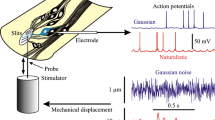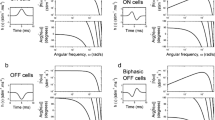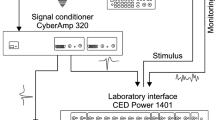Abstract
Experimental studies of certain sensory systems (e.g., vertebrate retinal cells and auditory fibers) have yielded qualitative evidence of the presence of nonlinear feedback. However, no methods have been available to provide the tools for quantitative analysis of this nonlinear feedback mechanism and subsequent modeling of the overall dynamics of these sensory systems. Recent results offer the analytical means to relate Wiener kernel measurements with corresponding nonlinear feedback models and, thus, the ability to model the overall dynamics of such sensory systems. Furthermore, our analytical results offer an explanation for experimentally observed changes in the waveform of Wiener kernel estimates obtained for different white-noise input mean and/or power levels.
Similar content being viewed by others
References
Barrett, J.F. The use of functionals in the analysis of nonlinear physical systems. J. Electron. Control 15:567–615; 1963.
Barrett, J.F. The use of Volterra series to find region of stability of a nonlinear differential equation. Int. J. Control 1:209–216; 1965.
Bedrosian, E.; Rice, S.O. The output properties of Volterra systems (nonlinear systems with memory) driven by harmonic and Gaussian inputs. Proc. IEEE 59:1688–1707; 1971.
Korenberg, M.J. Identification of nonlinear differential systems. Proc. Joint Autom. Cont. Conf. 597–603; 1973.
Korenberg, M.J. Identification of biological cascades of linear and static nonlinear systems. Proc. Midwest Symp. Circuit Theory 18(2):1–9; 1973.
Korenberg, M.J. Functional expansions, parallel cascades and nonlinear difference equations In: Marmarelis, V.Z., ed. Advanced methods of physiological system modeling: Vol. I. Los Angeles: Biomedical Simulations Resource, University of Southern California; 1987: pp. 221–240.
Korenberg, M.J. Identifying nonlinear difference equation and functional expansion representations: The fast orthogonal algorithm. Ann. Biomed. Eng. 16:123–142; 1988.
Lee, Y.W.; Schetzen, M. Measurement of the Wiener kernels of a nonlinear system by cross-correlation. Int. J. Control 2:237–254; 1965.
Marmarelis, P.Z.; Marmarelis, V.Z. Analysis of physiological systems: The white-noise approach. New York: Plenum; 1978 Russian translation, Moscow: Mir Press; 1982.
Marmarelis, P.Z.; Naka, K.-I. Nonlinear analysis and synthesis of receptive-field responses in the catfish retina. J. Neurophysiol. 36:634–648; 1973.
Marmarelis, V.Z., ed. Advanced methods of physiological system modeling: Vol. I. Los Angeles: Biomedical Simulations Resource, University of Southern California; 1987.
Marmarelis, V.Z., ed. Special issue on nonlinear modeling of physiological systems. Ann. Biomed. Eng. 16(1); 1988.
Marmarelis, V.Z., ed. Advanced methods of physiological system modeling: Vol. II. New York: Plenum; 1989.
Marmarelis, V.Z. Identification and modelling of a class of nonlinear systems. Math. Comput. Mod. 12:991–995; 1989.
Moller, A.R. Frequency selectivity of phase-locking of complex sounds in the auditory nerve of the rat. Hear. Res. 11:267–284; 1983.
Rugh, W.M. Nonlinear system theory: The Volterra/Wiener approach. Baltimore: Johns Hopkins Univ. Press; 1981.
Sakai, H.M.; Naka, K.-I. Signal transmission in the catfish retinal (V). J. Neurophysiol. 58:1329–1350; 1987.
Schetzen, M. The Volterra and Wiener theories of nonlinear systems. New York: Wiley; 1980.
Shi, J.H.; Sun, H.H. Nonlinear system identification for cascaded block model: An application, to electrode polarization impedance. IEEE Trans. Biomed. Eng. 37:574–587; 1990.
Volterra, V. Theory of functionals and of integral and integro-differential equations. New York: Dover; 1930.
Wiener, N. Nonlinear problems in random theory. New York: Wiley; 1958.
Author information
Authors and Affiliations
Rights and permissions
About this article
Cite this article
Marmarelis, V.Z. Wiener analysis of nonlinear feedback in sensory systems. Ann Biomed Eng 19, 345–382 (1991). https://doi.org/10.1007/BF02584316
Received:
Revised:
Issue Date:
DOI: https://doi.org/10.1007/BF02584316




